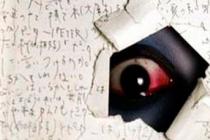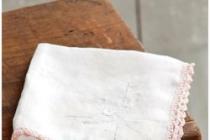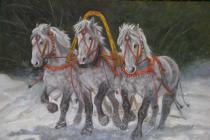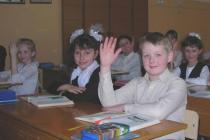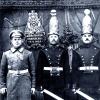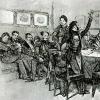In 1908 he entered the Imperial Technical School (later MVTU), and in 1918 he graduated with honors. Since 1909, member of the aeronautical circle. He participated in the construction of a glider, on which he made his first flight (1910).
In 1916-18, Tupolev participated in the work of the first aviation settlement bureau in Russia; designed the first wind tunnels at the school. Together with N. E. Zhukovsky, he was the organizer and one of the leaders of TsAGI. In 1918-36 - member of the board and deputy head of the institute for experimental all-metal aircraft construction.
Tupolev's milestone aircraft, which embodied the latest achievements of science and technology and aviation design in the pre-war period, were: ANT-4, ANT-6, ANT-40, ANT-42, Tu-2 bombers; passenger aircraft ANT-9, ANT-14, ANT-20 "Maxim Gorky" and the record-breaking ANT-25.
He was unreasonably repressed and in 1937-41, while in prison, he worked in the Central Committee B-29 of the NKVD. Here he created the front-line bomber "103" (Tu-2).
I bring to your attention an excerpt from the book by L.L. Kerbera "Tupolev":
“How could it happen that the Tupolevites celebrated the birth of their 58th (Tu-2) car in such unusual conditions (prison)? Who “helped” this? Let us turn to the well-known books by A.S. Yakovlev “The Purpose of Life” and “Soviet airplanes"? From what they say about A.N. Tupolev it follows that ANT:
did not prepare a replacement for the outdated, low-speed TB-3 bombers in a timely manner;
did not promptly try to increase the speed of the SB aircraft, which began to suffer significant losses from German fighters modified during the war in Spain;
Best of the day
did not create the bomber the Soviet Army needed by the beginning of the war.
Could A.S. be so ignorant? Yakovlev, aircraft designer, and since January 1940 - Deputy People's Commissar for Experimental Aircraft Construction? Could you not have known that:
In 1936, i.e. 5 years before the war, KOSOS prepared a replacement for the TB-3, created the TB-7 bomber, which had a speed 2 times greater than the TB-3?
In 1937, Tupolev was removed from work and repressed, so during the war in Spain he could not modernize the Security Council?
What else in 1940 did Tupolev develop the best front-line bomber of the Patriotic War - the "103" (Tu-2) aircraft?
A.S. Yakovlev, not only the author of a book on aviation, but also the leader’s adviser on these issues, naturally, willingly shared his views with him. With all the well-known suspicion of Stalin and his distrust of the old intelligentsia, is this not suitable ground for the question: is Tupolev completely loyal?
1937 In Spain, Me-109 fighters quickly improved by the Germans with more powerful engines are beginning to actively shoot down Tupolev SB bombers. Stalin is extremely upset: again the machines of this “old specialist” have defects. Why didn’t he improve his SB in time, because Yakovlev proved that this is possible. The unusually fast twin-engine Yak-4 aircraft he created, with the same engines as the SB, flies 100 km faster!
Having urgently launched the BB-22 into production, the military soon became convinced that they did not need the unarmed Yak-4, and when installing only two defensive machine guns and the necessary equipment on it, the speed gain disappeared. Several hundred BB-22s are being withdrawn from service; they are not suitable in the war with the Germans.
1942 In Omsk, the production of Tu-2 aircraft was established, a maximum of about 2-2.5 aircraft per day, but very nearby there were two aircraft factories that produced the already obsolete Il-4. Having a longer range and acceptable speed (smaller than the Tu-2), the Il-4s were distinguished by one significant drawback: weak defensive weapons (only two ShKAS). The losses of these vehicles were so great that they had to be transferred to night bombing, which was ineffective.
A natural thought arose about transferring the factories that produced the Il-4 to the Tu-2. However, a telegram soon arrived signed by Stalin: stop the production of Tu-2s, and instead begin producing Yak fighters."
My note: Production of Tu-2 aircraft was restored only in 1943. For the period 1942-1945 Only 1,216 Tu-2 aircraft were built, according to some sources, 800 aircraft during the war years (80 aircraft initially). For comparison, the similar Luftwaffe Ju-88 aircraft was produced in the amount of 15,200 aircraft.
The plane was really good and our army needed it. The creation of the Tu-2 by a group of convicts is undoubtedly an outstanding victory, a victory of an unbroken spirit.
In the post-war period, under the leadership of Tupolev (he has been the general designer since 1956), a number of military and civil aircraft were created: Tu-4 (a copy of the American B-29), Tu-12, Tu-95, Tu-16, Tu-22. On the basis of the Tu-16 bomber, the first Soviet jet passenger aircraft, Tu-104, was created in 1955. It was followed by the first turboprop intercontinental aircraft Tu-114, Tu-124, Tu-134, Tu-154, as well as the supersonic passenger aircraft Tu-144 (together with A. A. Tupolev).
A.N. Tupolev is an honorary member of the Royal Aeronautical Society of Great Britain (1970) and the American Institute of Aeronautics and Astronautics (1971). He was awarded the N. E. Zhukovsky Prize (1958), the FAI Gold Aviation Medal (1958), the Prize named after. Leonardo da Vinci (1971), gold medal of the Society of the Founders of Aviation of France (1971). Laureate of the Lenin Prize (1957), USSR State Prizes (1943, 1948, 1949, 1952, 1972). Awarded 8 orders of Lenin and Suvorov, 2nd degree.
Andrei Nikolaevich was born on October 29, 1888 in a large family in the village of Pustomazovo, located on the territory of modern Kalinin region. His mother, Anna Vasilievna, was the daughter of a forensic investigator from Tiflis. She was well educated, knew several languages, played the piano beautifully, took care of all the housework, and independently gave her children a primary education. Father, Nikolai Ivanovich Tupolev, was a Siberian Cossack, originally from Surgut. He worked as a notary of the district court, but did not like his job, and therefore acquired a small plot of land, settled on it and began farming.
Andrei Tupolev later recalled: “We lived modestly. I had older brothers Sergei and Nikolai, as well as sisters Natalya, Tatyana, Vera and Maria. Mother gave us all her strength, all her soul. Our family was very large and friendly. Not patriarchal, but undoubtedly advanced.”
Since 1901, Andrei Nikolaevich studied at the Tver gymnasium, about which he later wrote: “In order for the children to study, the whole family had to move to Tver. Our class was friendly, however, it was not customary to study well. I just tried to keep up with my peers. In Pustomazov I didn’t have any toys. They were expensive, and I made them myself from wood. And at the gymnasium there were manual labor classes. Here I could practice carpentry, and some of my things were even included in the exhibition. While studying at the gymnasium, I realized that I loved technology, I realized that I needed to go in this direction.” In the fall of 1908, Andrei Tupolev successfully passed exams at two educational institutions in Moscow: the Institute of Railway Engineers and IMTU. He chose IMTU.
Andrei Nikolaevich recalled about his first years in Moscow: “There was always a shortage of money. One day it became really bad, and then I decided to pawn my inferior coat at a pawnshop. I was looking for a pawn shop, and it seemed to me that everyone was looking at me, at the coat under my arm. I was never able to find the pawn shop and returned hungry that day. Fortunately, the next day, three rubles arrived from home.”
In October 1909, N.E. began giving lectures on aeronautics at IMTU. Zhukovsky, who also headed the Aeronautical Circle, formed on the initiative of students. In December of the same year, Tupolev came to the circle, for whom meeting Nikolai Egorovich had a fateful significance. He himself said that “from that moment my aviation life began.” After just four months, Andrei Tupolev became one of the most active participants in the circle. The works he completed - a flat wind tunnel and an airplane model - attracted the attention of people at the aeronautical exhibition that took place.
After the exhibition ended, the students began testing the balancing glider they had created. And the funds raised from ticket sales, combined with a number of private donations, made it possible for the circle to begin developing its own airplane. However, in the spring of 1911, Andrei's studies were unexpectedly interrupted. Having received information from an unknown source about Tupolev’s political unreliability, his room was searched, and he himself was detained. One of the first to try to help out the future designer was Zhukovsky, who stated that his student was busy in the circle and had no time for “extraneous” matters. The director of IMTU, Gavrilenko, also made an attempt to release Tupolev from custody. Despite all the petitions, Andrei Nikolaevich was released only in April due to the death of his father. He was also banned from living for exactly one year in any city with higher education institutions.
Tupolev spent about two and a half years in his native village, doing things far from aviation. He wrote: “When I returned home, I had the difficult task of burying my father. Things were going badly for our family. But I was young and strong. Having cultivated the land well, I planted vegetables. Gradually things began to improve.”
On February 6, 1913, police surveillance of A.N. Tupolev was canceled, and in the fall of this year he managed to recover at the ITU, continuing to work in the aerodynamic laboratory built on the basis of the old circle. Over the next year, he quickly became one of Zhukovsky's most active students, showing abilities as both a scientific researcher and a designer.
After the outbreak of World War I, the military department turned to Nikolai Yegorovich regarding the purging and examination of parts of aircraft that were in service. A sharp increase in the volume of work made it possible, with the support of the military, to organize the first Russian Aviation Design and Testing Bureau in the summer of 1916. It was headed by Professor Zhukovsky, and Tupolev became one of his assistants as head of laboratory facilities. In parallel with his research work, Andrei Nikolaevich managed to do aerodynamic calculations. In 1916, he calculated the Anatra airplane and the Kosyanenko brothers' fighter. On the recommendation of Zhukovsky, student Andrei Tupolev was involved in the commission developing strength standards for airplanes, in which, in addition to him, professors A.P. were present. Fan der Fleet, G.A. Botezat, S.P. Tymoshenko.
In 1916, Andrei Nikolaevich for some time supervised the design of a seaplane at the Dux plant. Here is what he himself wrote about this: “I had scanty experience, but I really wanted to try. They created a design bureau and began creating a seaplane. But the technical director of the plant, returning from France, brought a patent for the construction of a French model. They didn’t call me, they just told me through people that they would build a foreign plane, not one designed by me. I was young at that time, offended, I took the drawings and left.” However, later the drawings did come in handy, becoming the basis for Tupolev’s diploma.
The revolution in Russia did not interrupt the work of the Calculation and Testing Bureau; at the end of the summer of 1918, A.N. Tupolev headed the direction of aerodynamic calculations and instrument design. In the same year, he received the title of mechanical engineer, defending with honors a project entitled “Experience in creating a seaplane based on wind tunnel testing data.” In 1920, Tupolev tried himself as a teacher, giving a course of lectures at the Moscow Higher Technical School “Fundamentals of aerodynamic calculations”. The following year, he was already assigned the “Theory of Airplanes”, “Theory of Seaplanes”, “Normal and Special Design of Seaplanes”, as well as the course “Hydroaviation” at the Institute. NOT. Zhukovsky.
Soon Nikolai Egorovich and a number of his closest associates came to the conclusion that further development of aircraft manufacturing in the country is possible only if there is a powerful research base. The idea of creating a scientific aerohydrodynamic institute was personally supported by V.I. Lenin and in December 1918 he began his activities. The Central Aerohydrodynamic Institute (abbreviated as TsAGI) was headed by Zhukovsky, and Tupolev became the head of the aviation department. From the very beginning, he set before his employees tasks that were not at all aerohydrodynamic, aimed at developing a whole complex of scientific developments necessary in the future for aircraft construction. The institute studied aircraft alloys and their protection from corrosion, aircraft engines, the strength of aircraft structures, flight test methods, and much more. After the death of Zhukovsky, Tupolev continued his work on the further development and expansion of TsAGI. To solve emerging issues, he widely attracted specialists and scientists from various fields of science.
A goal appeared in Andrei Nikolaevich’s life - to create a whole new industry, the aviation industry, capable of mass development and production of aircraft. In 1924, thanks to Tupolev’s proposal, the country’s top leadership decided to create a metallurgical base for aircraft manufacturing, which made it possible to produce large quantities of special aviation materials. At the insistence of Tupolev, lightweight magnesium alloys were developed in the 30s, and high-strength aluminum alloys for high-speed aircraft were developed in the late 40s. At the end of the 60s, new heat-resistant aluminum-based alloys appeared for supersonic aircraft. It was Tupolev who first began to use high-strength chromansil steel, fiberglass and some other non-metallic materials. A special laboratory was organized to create and study them.
In 1923, Tupolev created the all-metal, highly reliable ANT-P snowmobile; the experience gained later allowed him to develop new designs for gliders and naval torpedo boats, which were mass-produced during the Great Patriotic War. And in 1924, flight tests of the first all-metal aircraft ANT-2 ended in success.

ANT-2
Step by step, using the example of foreign models and our own experience, production and design teams were formed at TsAGI, production facilities and workshops were expanded, and new buildings were built. Having become the chief engineer of the Main Directorate of the Aviation Industry in 1936, A.N. Tupolev begins to rebuild old and build new aircraft factories for mass production of aircraft. To do this, he makes extensive use of advanced imported equipment, and also follows the principles used in the US automotive industry, which he had the opportunity to study during a number of business trips. Thanks to Andrey Nikolaevich, technological processes developed abroad were introduced, including cladding and anodizing. These events helped organize mass production of aircraft during the war. Tupolev was also one of the first to understand the need to use computers to improve calculation methods and increase the number of factors taken into account, creating one of the first computer centers.
Each new Tupolev aircraft was an event in technology. Based on his experience, he included in each project only the minimum amount of new things, using the path of sequential construction of aircraft. For example, the aircraft "77", "73" and "82" served as stages for the creation of the Tu-16 twin-engine jet bomber. Among the aircraft created by Tupolev there were models that were not mass-produced, but there were no unfinished ones that were unable to fly.

Tu-16
After the end of the war, Tupolev began the construction of new laboratory and production buildings, specialized workshops and branches, and founded a flight development base. Not forgetting about his employees, he sought the construction of new houses and recreation centers, garden cooperatives and kindergartens for them.
Tupolev is the author of many unique technical solutions, such as the prototyping method, capable of solving spatial layout problems on wooden models, or the creation of entire flying laboratories for testing engines and other aircraft systems. Eyewitnesses said that no matter where Andrei Nikolaevich was, no matter what he did, his head was constantly thinking about what he had read, heard or seen that could be used for the development of aircraft construction.
The great designer always knew how to correctly interpret the tasks assigned to the future aircraft. When developing the ANT-31 in 1932, Tupolev was the first to understand the main task of new generation fighters - to catch up with the enemy. By the beginning of the war, the monoplane design had become the standard for all fighter aircraft in the world. And in 1950, he realized the advantage of heavy jet bombers over aircraft with piston engines, and began designing the Tu-16, which later amazed many specialists.
Tupolev loved well-detailed preliminary layouts. He said: “The more details they drew, the more problems they thought about.” He responded about the careless layouts: “They smeared it without thinking.” Tupolev also did not tolerate speculative conclusions. Wherever, at whatever level the meeting took place, he made decisions only on the basis of experimental results or those obtained through careful calculations.
To eliminate the defects identified during the flight tests, Tupolev organized a wide technical process with the participation of specialists from various industries. He devoted a lot of time to working with aircraft crews, helping to improve their theoretical and practical training. For this purpose, aerobatic training stands for pilots were created. Before the first flight, Tupolev had a long conversation with the pilots, telling them about the creation of the aircraft, thereby instilling his confidence in the device. And after the flight he asked for detailed stories about what the pilots learned and felt. Of course, the designer had to witness disasters and accidents of his test and production aircraft. People were dying, and, feeling his responsibility to their relatives, Andrei Nikolaevich used all his authority and influence to help the families of the victims, seeking pensions and benefits. In addition, he conducted a thorough search for the causes of the incident, eliminated all defects and defended in disputes with management the need to continue testing this model. As a rule, his arguments were accepted, and the plane was then operated successfully for a long time (for example, this was the case with the Tu-134). Later, Tupolev came up with a service for operating mass-produced aircraft. Based on the data it collected, decisions were made on further modernization of the aircraft.

Tu-134
In total, under the leadership of Andrei Nikolaevich, more than fifty original aircraft and about a hundred different modifications were created. His aircraft set more than one hundred world records for range, flight speed and payload. The main line of Tupolev's creativity was heavy aircraft with a high payload. In 1958, under his leadership, a unique passenger aircraft, the Tu-114, was created, which was far ahead of its time. The reliable, ultra-long-range airbus has gained leadership on long-distance routes for many years, having no analogues in terms of economic efficiency. The Tu-114 operated on international routes, flying across the ocean to Cuba and America. Over the years of operation, aircraft of this series have set thirty-two world records and there is no data in the column of flight accidents. And the supersonic passenger airliner Tu-144, which appeared in 1968, became famous not only in the USSR, but throughout the world.

Tu-114
Tupolev, soberly assessing the importance of money, always stated: “Creating a small aircraft requires little money and a lot of labor. A big plane means a lot of work, and also a lot of money.”
Andrei Nikolaevich was a famous statesman and public figure - a deputy of the Supreme Soviet of the USSR and the Moscow City Council, a member of the All-Russian Central Executive Committee. His speeches were always distinguished by their emotionality and breadth of judgment, expressing hopes for a bright future for humanity. Tupolev was three times Hero of Socialist Labor, laureate of many State Prizes, winner of numerous orders and medals. What is especially curious is that the famous scientist was awarded the Leonardo da Vinci Prize and the gold medal of the Society of the Founders of Aviation in France. He was elected an honorary member of the Royal Aeronautical Society of Great Britain and the American Institute of Aeronautics and Astronautics.
According to eyewitnesses, Tupolev had an almost supernatural ability to accurately guess where the plane would take off from the ground during acceleration and where the aircraft would end its run after landing. Tupolev demonstrated such a gift more than once or twice, even in unusual situations such as the takeoff of an extremely overloaded plane.
Being a talented scientist and designer, the leader of a huge team of thousands of engineers, technologists, test pilots, technicians and workers, Andrei Nikolaevich always remained a very simple and friendly person, he adored his family, nature, the company of friends, and delicious food. In everyday life, Tupolev was extremely conservative, preferring to wear old but comfortable jackets, trousers, and shoes. It was very difficult to get him to buy a new thing. Andrei Tupolev met his wife while still a student and all his life he loved only her. Yulia Nikolaevna accompanied him wherever possible: on business trips abroad, at scientific conferences, ceremonial and friendly open receptions. Often in a large company she was the only woman. Knowing foreign languages well, Yulia Nikolaevna helped Tupolev in negotiations with foreigners.
It is a known fact that Andrei Nikolaevich involved his wife in the design of passenger cabins of Tu-70 and Tu-104 aircraft. Yulia Nikolaevna enthusiastically chose the colors of the material for the interior and chairs, equipment of the interior and kitchen, being a supporter of the Russian traditional style. It is safe to say that she was one of the first designers of the OKB.
Andrei Tupolev loved to travel. As part of official delegations and on business trips, he visited many countries, where he studied not only science and technology, but also nature, people, and local customs. On vacation, he preferred to hunt, fish, and play volleyball. I was especially happy when I was able to go out into nature with my family and closest friends, sit by the fire, and cook fish soup. He went to the theater and cinema, listened to music, but due to his busy schedule, and in recent years due to illness, he could not devote much time to this. But regularly, before going to bed, I read works of fiction. His home library, in addition to numerous technical books and magazines, contained books by A.S. Pushkina, L.N. Tolstoy, A.T. Tvardovsky, D. Galsworthy, Plutarch. Tupolev remembered many poems and quoted them from time to time. In general, his speech was distinguished by brevity and capacity; many phrases became aphorisms.
Andrei Nikolaevich had one habit. He always brought home something tasty from guests or from an official reception: a cake, an apple, a pie. Many colleagues, knowing this, specially wrapped Tupolev a treat “for home.”
When the grandchildren appeared - first Yulia, and later Andryusha and Tanya - Andrei Nikolaevich began to spend all his free time with them. Tupolev often picked up carpentry tools and carved wooden toys for his grandchildren.
Unfortunately, Yulia Nikolaevna was in poor health, and in the post-war years, Andrei Nikolaevich was accompanied on numerous trips by his daughter, Yulia Andreevna. After the death of his wife in 1962, Tupolev lost weight, became more withdrawn and thoughtful, but did not work less. His daughter was at home with him almost all the time. Tupolev highly valued her medical experience, not taking any medicine or medical procedure without his daughter's approval.
Andrei Nikolaevich maintained friendly relations with I.V. Kurchatov, A.P. Vinogradov, A.T. Tvardovsky, M.V. Keldysh, P.L. Kapitsa and many other outstanding people of that time. S.P. often came to talk to him. Korolev, who later said that he learned from Andrei Nikolaevich’s work style. Under the guidance of Tupolev, Korolev did his graduation project and also worked a little in his assembly shop.
Until the last days of his life, Tupolev retained a strong memory and clear consciousness, was interested in everything and participated in the most important affairs of his design bureau. Talking at the MGTS hospital on December 22, 1972 with his son and daughter who visited him, eighty-four-year-old Andrei Nikolaevich Tupolev laughed and joked, making plans for a trip to Crimea. When they left late in the evening, he fell asleep and never woke up.

Ctrl Enter
Noticed osh Y bku Select text and click Ctrl+Enter
Andrey Nikolaevich Tupolev(October 29 (November 10), 1888, village of Pustomazovo, Kimry district, Tver region, - December 23, 1972, Moscow) - Russian and Soviet aircraft designer, academician of the USSR Academy of Sciences. Colonel General Engineer (1968). Hero of Labor (1926). Three times Hero of Socialist Labor (1945, 1957, 1972).
Under the leadership of Tupolev, over 100 types of aircraft were designed, 70 of which were built in series. His planes set 78 world records and performed about 30 outstanding flights.
Tupolev trained a galaxy of prominent aviation designers and scientists who headed aircraft design bureaus. Among them are V. M. Petlyakov, P. O. Sukhoi, V. M. Myasishchev, A. I. Putilov, V. A. Chizhevsky, A. A. Arkhangelsky, M. L. Mil, A. P. Golubkov , I. F. Nezval, A. A. Tupolev, S. A. Lavochkin
Childhood
Born on October 29 (November 10), 1888, in the village of Pustomazovo (now Kimry district) of the Tver province, in the family of a provincial notary.
Of course, you can make candy out of shit. But it will be shit candy.
Tupolev Andrey Nikolaevich
Higher education
Even while studying at the gymnasium, he showed great interest in exact sciences and technology. In 1908 he entered the Imperial Moscow Technical School (later MVTU). At school I became seriously interested in aerodynamics. Since 1909 - member of the aeronautical circle. He participated in the construction of a glider, on which he made his first flight (1910). In 1911, successful studies and active scientific work were interrupted when, for participating in unrest and distributing illegal literature, he was arrested and administratively expelled from Moscow to his homeland under the secret supervision of the police. Only on the eve of the First World War did he manage to return to school, from which he graduated with honors in 1918.
Professional activity
In 1916-1918, Tupolev participated in the work of the first aviation settlement bureau in Russia; designed the first wind tunnels at the school. Together with N. E. Zhukovsky, he was the organizer and one of the leaders of TsAGI, where the vocation of the young engineer was finally determined. In 1918-1936 he was a member of the board and deputy head of the institute for experimental all-metal aircraft construction. He experimentally proved that chain mail aluminum (originally named after the Kolchuginsky plant in the Vladimir region, where duralumin was made for the first time in Soviet Russia) is a worthy replacement for fragile wood, on the one hand, and heavy iron, on the other, for aircraft construction
On October 21, 1937, A. N. Tupolev was arrested on charges of sabotage and belonging to a counter-revolutionary organization. Along with him, many leading specialists from TsAGI and the Design Bureau, directors of most aircraft factories, were arrested. On May 28, 1940, he was sentenced by the USSR Higher Military Command to 15 years in labor camp. He was accused of creating a sabotage organization that transferred aircraft drawings to foreign intelligence. The verdict was absolutely absurd. According to the testimony of Air Chief Marshal A.E. Golovanov, in a conversation with him, Stalin said that he did not believe that Tupolev was guilty. The compromising facts considered by the investigation had nothing to do with the content of the verdict. (the case was led by Gabitov, an employee of the 2nd investigative department of the NKVD). Exactly, January 5, 1936. By order of the NKOP, Tupolev (on the recommendation of the People's Commissar of the NKTP Ordzhonikidze) is appointed first deputy and chief engineer of the NKOP Main Directorate. In the same year, a delegation of aviation industry workers was sent to the United States to purchase equipment and licenses. Tupolev (PSU) and Kharlamov (TsAGI) were appointed heads of the delegation.
The trip to the USA was Tupolev’s second. The first time he visited Germany and the USA was in 1930, when he was the head of the AGOS on the issue of airship construction. This time the delegation’s route passed through France, where they inspected the products of the French aviation industry. Knowledge of the French language helped Tupolev find common ground in the area of purchasing aircraft engines. While in the USA, Tupolev violated the accepted rule of placing orders through the consulting and trading company AMTORG. This company was created by the Soviet government in the early 20s with the aim of placing orders at the Ford, Christie and Curtiss factories. Tupolev, having met with the American designer A. N. Seversky (Prokofiev-Seversky emigrated to the USA in 1917), placed orders at his own discretion (Prokofiev’s influence). Between Tupolev and the head of the OsTekhBuro brigade commander P.I. Grokhovsky (was part of the delegation, self-taught, when he was in the 3rd grade of primary school, he was able to make 63 inventions in the field of aviation, artillery and armored vehicles, knew two foreign languages, in 1937 he was arrested in the Tukhachevsky case, died in 1946, while in OTB-172), a scandal arose that was difficult to extinguish. In addition, Tupolev was on a business trip with his wife Yulia Nikolaevna, who had nothing to do with aviation. As a result of the trip, licenses were purchased for the production of aircraft Valti V-IA, Consolidated PBY-1 (built in the USSR in limited numbers, they were very difficult to manufacture) and a Seversky 2RA fighter, which did not meet the strength standards adopted by the Red Army Air Force. Thanks to Petlyakov, who was also part of the delegation, it was possible to acquire a license for a modern Douglas DC-3 aircraft at that time. While in prison, he worked in the closed NKVD design bureau - TsKB-29 (“Tupolev Sharaga”).
In July 1941, he was released from further serving of his sentence with his criminal record expunged. Tupolev was completely rehabilitated on April 9, 1955.
Aircrafts
In 1925, Andrei Nikolaevich created the all-metal twin-engine aircraft TB-1, which was distinguished by high flight performance and was considered one of the best bombers in the world. In 1932, an improved TB-3 aircraft was designed, with the help of which the expedition landed at the North Pole in 1937. Also in 1932, under the leadership of Tupolev, the ANT-25 aircraft was designed by P. O. Sukhoi’s brigade. In 1934, a multi-engine aircraft of the Maxim Gorky model appeared. It had eight engines, a usable area of more than 100 m² and a passenger capacity of up to 60 people.
After World War II, the Tupolev Design Bureau developed and produced a new model - the Tu-16 jet bomber. It was capable of speeds of more than 1000 km/h. The first domestic jet civil aircraft, the Tu-104, also appeared.
In 1957, the Tu-114 turboprop intercontinental passenger aircraft was developed.
Member of the USSR Central Executive Committee. Deputy of the Supreme Soviet of the USSR (1950-72).
Family
Son Alexey Andreevich Tupolev is a famous Soviet aircraft designer.
Daughter Yulia Andreevna Tupoleva - Honored Doctor of the Russian Federation, head of the therapeutic department of the Moscow State Clinical Hospital named after S. P. Botkin, personal physician of Andrei Nikolaevich Tupolev
Son-in-law Vladimir Mikhailovich Vul - leading designer of the Tupolev Design Bureau, deputy general designer
Memory
- Streets in Moscow, St. Petersburg, Voronezh, Rostov-on-Don, Donetsk, Kiev, Prague, Bratislava, Omsk, Ulan-Ude, Ulyanovsk, Tver, Krivoy Rog, Zhukovsky, Kimry, Tyumen are named after A. N. Tupolev.
- In 1973, the Kazan Aviation Institute was named after Tupolev (since 1992 - Kazan State Technical University named after A. N. Tupolev).
- In the city of Kimry, on Mayskaya Square, on September 7, 1979, a bust of A. N. Tupolev (sculptor Kh. B. Gevorkyan) was erected.
- In 1988, a USSR postage stamp dedicated to Tupolev was issued.
- In 1979, a biography film was made dedicated to two great aircraft designers A. N. Tupolev and I. I. Sikorsky - “Poem about Wings.”
- A memorial was erected on the site where Tupolev’s native village of Pustomazovo was located. Now the territory of the Ustinovsky rural settlement of the Kimry district of the Tver region.
Awards and titles
- Hero of Labor (1926).
- three times Hero of Socialist Labor (1945, 1957, 1972).
- eight Orders of Lenin (2/21/1933, 9/16/1945, 7/8/1947, January 1949, December 1949, 1953, 1958, 1968)
- Order of the October Revolution (1971)
- Order of Suvorov, II degree (1944)
- Order of the Patriotic War, 1st degree (1943)
- two Orders of the Red Banner of Labor (1927, 12/22/1933)
- Order of the Red Star (17.8.1933)
- Order of the Badge of Honor (1936)
- Order "Georgi Dimitrov" (People's Republic of Bulgaria, 1964)
- medals
- Honored Worker of Science and Technology of the RSFSR (8.8.1947)
- Lenin Prize (1957) - for the creation of a high-speed jet passenger aircraft Tu-104
- Stalin Prize of the first degree (1943) - for the creation of a new type of combat aircraft
- Stalin Prize, first degree (1948) - for the creation of new combat aircraft
- Stalin Prize (?) degree (1949)
- Stalin Prize, first degree (1952) - for work in the field of aircraft construction
- USSR State Prize (1972) - for the creation of the high-speed passenger aircraft Tu-134 and its modifications
- Prize named after N. E. Zhukovsky (1958)
- FAI Gold Aviation Medal (1958)
- Leonardo da Vinci Prize (1971)
- Gold medal of the Society of the Founders of Aviation of France (1971).
- Honorary member of the Royal Aeronautical Society of Great Britain (1970) and the American Institute of Aeronautics and Astronautics (1971).
- Honorary citizen of Paris (1964), New York and the city of Zhukovsky, Moscow region (1968).
Andrey Nikolaevich Tupolev - quotes
Only beautiful planes fly well. ![]()
I don't write, I do. ![]()
Andrei Tupolev later recalled: “We lived modestly. I had older brothers Sergei and Nikolai, as well as sisters Natalya, Tatyana, Vera and Maria. Mother gave us all her strength, all her soul. Our family was very large and friendly. Not patriarchal, but undoubtedly advanced.”
Since 1901, Andrei Nikolaevich studied at the Tver gymnasium, about which he later wrote: “In order for the children to study, the whole family had to move to Tver. Our class was friendly, however, it was not customary to study well. I just tried to keep up with my peers. In Pustomazov I didn’t have any toys. They were expensive, and I made them myself from wood. And at the gymnasium there were manual labor classes. Here I could practice carpentry, and some of my things were even included in the exhibition. While studying at the gymnasium, I realized that I loved technology, I realized that I needed to go in this direction.” In the fall of 1908, Andrei Tupolev successfully passed exams at two educational institutions in Moscow: the Institute of Railway Engineers and IMTU. He chose IMTU.
Andrei Nikolaevich recalled about his first years in Moscow: “There was always a shortage of money. One day it became really bad, and then I decided to pawn my inferior coat at a pawnshop. I was looking for a pawn shop, and it seemed to me that everyone was looking at me, at the coat under my arm. I was never able to find the pawn shop and returned hungry that day. Fortunately, the next day, three rubles arrived from home.”
In October 1909, N.E. began giving lectures on aeronautics at IMTU. Zhukovsky, who also headed the Aeronautical Circle, formed on the initiative of students. In December of the same year, Tupolev came to the circle, for whom meeting Nikolai Egorovich had a fateful significance. He himself said that “from that moment my aviation life began.” After just four months, Andrei Tupolev became one of the most active participants in the circle. The works he completed - a flat wind tunnel and an airplane model - attracted the attention of people at the aeronautical exhibition that took place.
After the exhibition ended, the students began testing the balancing glider they had created. And the funds raised from ticket sales, combined with a number of private donations, made it possible for the circle to begin developing its own airplane. However, in the spring of 1911, Andrei's studies were unexpectedly interrupted. Having received information from an unknown source about Tupolev’s political unreliability, his room was searched, and he himself was detained. One of the first to try to help out the future designer was Zhukovsky, who stated that his student was busy in the circle and had no time for “extraneous” matters. The director of IMTU, Gavrilenko, also made an attempt to release Tupolev from custody. Despite all the petitions, Andrei Nikolaevich was released only in April due to the death of his father. He was also banned from living for exactly one year in any city with higher education institutions.
Tupolev spent about two and a half years in his native village, doing things far from aviation. He wrote: “When I returned home, I had the difficult task of burying my father. Things were going badly for our family. But I was young and strong. Having cultivated the land well, I planted vegetables. Gradually things began to improve.”
On February 6, 1913, police surveillance of A.N. Tupolev was canceled, and in the fall of this year he managed to recover at the ITU, continuing to work in the aerodynamic laboratory built on the basis of the old circle. Over the next year, he quickly became one of Zhukovsky's most active students, showing abilities as both a scientific researcher and a designer.
After the outbreak of World War I, the military department turned to Nikolai Yegorovich regarding the purging and examination of parts of aircraft that were in service. A sharp increase in the volume of work made it possible, with the support of the military, to organize the first Russian Aviation Design and Testing Bureau in the summer of 1916. It was headed by Professor Zhukovsky, and Tupolev became one of his assistants as head of laboratory facilities. In parallel with his research work, Andrei Nikolaevich managed to do aerodynamic calculations. In 1916, he calculated the Anatra airplane and the Kosyanenko brothers' fighter. On the recommendation of Zhukovsky, student Andrei Tupolev was involved in the commission developing strength standards for airplanes, in which, in addition to him, professors A.P. were present. Fan der Fleet, G.A. Botezat, S.P. Tymoshenko.
In 1916, Andrei Nikolaevich for some time supervised the design of a seaplane at the Dux plant. Here is what he himself wrote about this: “I had scanty experience, but I really wanted to try. They created a design bureau and began creating a seaplane. But the technical director of the plant, returning from France, brought a patent for the construction of a French model. They didn’t call me, they just told me through people that they would build a foreign plane, not one designed by me. I was young at that time, offended, I took the drawings and left.” However, later the drawings did come in handy, becoming the basis for Tupolev’s diploma.
The revolution in Russia did not interrupt the work of the Calculation and Testing Bureau; at the end of the summer of 1918, A.N. Tupolev headed the direction of aerodynamic calculations and instrument design. In the same year, he received the title of mechanical engineer, defending with honors a project entitled “Experience in creating a seaplane based on wind tunnel testing data.” In 1920, Tupolev tried himself as a teacher, giving a course of lectures at the Moscow Higher Technical School “Fundamentals of aerodynamic calculations”. The following year, he was already assigned the “Theory of Airplanes”, “Theory of Seaplanes”, “Normal and Special Design of Seaplanes”, as well as the course “Hydroaviation” at the Institute. NOT. Zhukovsky.
Soon Nikolai Egorovich and a number of his closest associates came to the conclusion that further development of aircraft manufacturing in the country is possible only if there is a powerful research base. The idea of creating a scientific aerohydrodynamic institute was personally supported by V.I. Lenin and in December 1918 he began his activities. The Central Aerohydrodynamic Institute (abbreviated as TsAGI) was headed by Zhukovsky, and Tupolev became the head of the aviation department. From the very beginning, he set before his employees tasks that were not at all aerohydrodynamic, aimed at developing a whole complex of scientific developments necessary in the future for aircraft construction. The institute studied aircraft alloys and their protection from corrosion, aircraft engines, the strength of aircraft structures, flight test methods, and much more. After the death of Zhukovsky, Tupolev continued his work on the further development and expansion of TsAGI. To solve emerging issues, he widely attracted specialists and scientists from various fields of science.
A goal appeared in Andrei Nikolaevich’s life - to create a whole new industry, the aviation industry, capable of mass development and production of aircraft. In 1924, thanks to Tupolev’s proposal, the country’s top leadership decided to create a metallurgical base for aircraft manufacturing, which made it possible to produce large quantities of special aviation materials. At the insistence of Tupolev, lightweight magnesium alloys were developed in the 30s, and high-strength aluminum alloys for high-speed aircraft were developed in the late 40s. At the end of the 60s, new heat-resistant aluminum-based alloys appeared for supersonic aircraft. It was Tupolev who first began to use high-strength chromansil steel, fiberglass and some other non-metallic materials. A special laboratory was organized to create and study them.
In 1923, Tupolev created the all-metal, highly reliable ANT-P snowmobile; the experience gained later allowed him to develop new designs for gliders and naval torpedo boats, which were mass-produced during the Great Patriotic War. And in 1924, flight tests of the first all-metal aircraft ANT-2 ended in success.

Step by step, using the example of foreign models and our own experience, production and design teams were formed at TsAGI, production facilities and workshops were expanded, and new buildings were built. Having become the chief engineer of the Main Directorate of the Aviation Industry in 1936, A.N. Tupolev begins to rebuild old and build new aircraft factories for mass production of aircraft. To do this, he makes extensive use of advanced imported equipment, and also follows the principles used in the US automotive industry, which he had the opportunity to study during a number of business trips. Thanks to Andrey Nikolaevich, technological processes developed abroad were introduced, including cladding and anodizing. These events helped organize mass production of aircraft during the war. Tupolev was also one of the first to understand the need to use computers to improve calculation methods and increase the number of factors taken into account, creating one of the first computer centers.
Each new Tupolev aircraft was an event in technology. Based on his experience, he included in each project only the minimum amount of new things, using the path of sequential construction of aircraft. For example, the aircraft "77", "73" and "82" served as stages for the creation of the Tu-16 twin-engine jet bomber. Among the aircraft created by Tupolev there were models that were not mass-produced, but there were no unfinished ones that were unable to fly.

After the end of the war, Tupolev began the construction of new laboratory and production buildings, specialized workshops and branches, and founded a flight development base. Not forgetting about his employees, he sought the construction of new houses and recreation centers, garden cooperatives and kindergartens for them.
Tupolev is the author of many unique technical solutions, such as the prototyping method, capable of solving spatial layout problems on wooden models, or the creation of entire flying laboratories for testing engines and other aircraft systems. Eyewitnesses said that no matter where Andrei Nikolaevich was, no matter what he did, his head was constantly thinking about what he had read, heard or seen that could be used for the development of aircraft construction.
The great designer always knew how to correctly interpret the tasks assigned to the future aircraft. When developing the ANT-31 in 1932, Tupolev was the first to understand the main task of new generation fighters - to catch up with the enemy. By the beginning of the war, the monoplane design had become the standard for all fighter aircraft in the world. And in 1950, he realized the advantage of heavy jet bombers over aircraft with piston engines, and began designing the Tu-16, which later amazed many specialists.
Tupolev loved well-detailed preliminary layouts. He said: “The more details they drew, the more problems they thought about.” He responded about the careless layouts: “They smeared it without thinking.” Tupolev also did not tolerate speculative conclusions. Wherever, at whatever level the meeting took place, he made decisions only on the basis of experimental results or those obtained through careful calculations.
To eliminate the defects identified during the flight tests, Tupolev organized a wide technical process with the participation of specialists from various industries. He devoted a lot of time to working with aircraft crews, helping to improve their theoretical and practical training. For this purpose, aerobatic training stands for pilots were created. Before the first flight, Tupolev had a long conversation with the pilots, telling them about the creation of the aircraft, thereby instilling his confidence in the device. And after the flight he asked for detailed stories about what the pilots learned and felt. Of course, the designer had to witness disasters and accidents of his test and production aircraft. People were dying, and, feeling his responsibility to their relatives, Andrei Nikolaevich used all his authority and influence to help the families of the victims, seeking pensions and benefits. In addition, he conducted a thorough search for the causes of the incident, eliminated all defects and defended in disputes with management the need to continue testing this model. As a rule, his arguments were accepted, and the plane was then operated successfully for a long time (for example, this was the case with the Tu-134). Later, Tupolev came up with a service for operating mass-produced aircraft. Based on the data it collected, decisions were made on further modernization of the aircraft.

In total, under the leadership of Andrei Nikolaevich, more than fifty original aircraft and about a hundred different modifications were created. His aircraft set more than one hundred world records for range, flight speed and payload. The main line of Tupolev's creativity was heavy aircraft with a high payload. In 1958, under his leadership, a unique passenger aircraft, the Tu-114, was created, which was far ahead of its time. The reliable, ultra-long-range airbus has gained leadership on long-distance routes for many years, having no analogues in terms of economic efficiency. The Tu-114 operated on international routes, flying across the ocean to Cuba and America. Over the years of operation, aircraft of this series have set thirty-two world records and there is no data in the column of flight accidents. And the supersonic passenger airliner Tu-144, which appeared in 1968, became famous not only in the USSR, but throughout the world.

Tupolev, soberly assessing the importance of money, always stated: “Creating a small aircraft requires little money and a lot of labor. A big plane means a lot of work, and also a lot of money.”
Andrei Nikolaevich was a famous statesman and public figure - a deputy of the Supreme Soviet of the USSR and the Moscow City Council, a member of the All-Russian Central Executive Committee. His speeches were always distinguished by their emotionality and breadth of judgment, expressing hopes for a bright future for humanity. Tupolev was three times Hero of Socialist Labor, laureate of many State Prizes, winner of numerous orders and medals. What is especially curious is that the famous scientist was awarded the Leonardo da Vinci Prize and the gold medal of the Society of the Founders of Aviation in France. He was elected an honorary member of the Royal Aeronautical Society of Great Britain and the American Institute of Aeronautics and Astronautics.
According to eyewitnesses, Tupolev had an almost supernatural ability to accurately guess where the plane would take off from the ground during acceleration and where the aircraft would end its run after landing. Tupolev demonstrated such a gift more than once or twice, even in unusual situations such as the takeoff of an extremely overloaded plane.
Being a talented scientist and designer, the leader of a huge team of thousands of engineers, technologists, test pilots, technicians and workers, Andrei Nikolaevich always remained a very simple and friendly person, he adored his family, nature, the company of friends, and delicious food. In everyday life, Tupolev was extremely conservative, preferring to wear old but comfortable jackets, trousers, and shoes. It was very difficult to get him to buy a new thing. Andrei Tupolev met his wife while still a student and all his life he loved only her. Yulia Nikolaevna accompanied him wherever possible: on business trips abroad, at scientific conferences, ceremonial and friendly open receptions. Often in a large company she was the only woman. Knowing foreign languages well, Yulia Nikolaevna helped Tupolev in negotiations with foreigners.
It is a known fact that Andrei Nikolaevich involved his wife in the design of passenger cabins of Tu-70 and Tu-104 aircraft. Yulia Nikolaevna enthusiastically chose the colors of the material for the interior and chairs, equipment of the interior and kitchen, being a supporter of the Russian traditional style. It is safe to say that she was one of the first designers of the OKB.
Andrei Tupolev loved to travel. As part of official delegations and on business trips, he visited many countries, where he studied not only science and technology, but also nature, people, and local customs. On vacation, he preferred to hunt, fish, and play volleyball. I was especially happy when I was able to go out into nature with my family and closest friends, sit by the fire, and cook fish soup. He went to the theater and cinema, listened to music, but due to his busy schedule, and in recent years due to illness, he could not devote much time to this. But regularly, before going to bed, I read works of fiction. His home library, in addition to numerous technical books and magazines, contained books by A.S. Pushkina, L.N. Tolstoy, A.T. Tvardovsky, D. Galsworthy, Plutarch. Tupolev remembered many poems and quoted them from time to time. In general, his speech was distinguished by brevity and capacity; many phrases became aphorisms.
Andrei Nikolaevich had one habit. He always brought home something tasty from guests or from an official reception: a cake, an apple, a pie. Many colleagues, knowing this, specially wrapped Tupolev a treat “for home.”
When the grandchildren appeared - first Yulia, and later Andryusha and Tanya - Andrei Nikolaevich began to spend all his free time with them. Tupolev often picked up carpentry tools and carved wooden toys for his grandchildren.
Unfortunately, Yulia Nikolaevna was in poor health, and in the post-war years, Andrei Nikolaevich was accompanied on numerous trips by his daughter, Yulia Andreevna. After the death of his wife in 1962, Tupolev lost weight, became more withdrawn and thoughtful, but did not work less. His daughter was at home with him almost all the time. Tupolev highly valued her medical experience, not taking any medicine or medical procedure without his daughter's approval.
Andrei Nikolaevich maintained friendly relations with I.V. Kurchatov, A.P. Vinogradov, A.T. Tvardovsky, M.V. Keldysh, P.L. Kapitsa and many other outstanding people of that time. S.P. often came to talk to him. Korolev, who later said that he learned from Andrei Nikolaevich’s work style. Under the guidance of Tupolev, Korolev did his graduation project and also worked a little in his assembly shop.
Until the last days of his life, Tupolev retained a strong memory and clear consciousness, was interested in everything and participated in the most important affairs of his design bureau. Talking at the MGTS hospital on December 22, 1972 with his son and daughter who visited him, eighty-four-year-old Andrei Nikolaevich Tupolev laughed and joked, making plans for a trip to Crimea. When they left late in the evening, he fell asleep and never woke up.
Andrei Nikolaevich Tupolev was born on November 10 (October 29, old style) 1888 in the village of Pustomazovo near the city of Kimry, Tver province (region) in a large family. His mother was from the nobility, his father was from commoners.
In 1906, Andrei Tupolev graduated from high school in the city of Tver.
In 1908 he entered the Imperial Moscow Technical School (later MVTU). While studying under the guidance of Nikolai Zhukovsky, he began studying in an aeronautics club. In 1910 he made the first flight on a glider, the construction of which he participated in.
In 1911, for participating in student unrest, Tupolev was expelled from the school and exiled to his homeland for two years under police supervision.
In 1916-1918, he participated in the work of the first aviation settlement bureau in Russia; designed the first wind tunnels at the school.
In 1918, Tupolev graduated with honors from the Moscow Higher Technical School and, together with Zhukovsky, became the organizer and one of the leaders of the Central Aerohydrodynamic Institute (TsAGI). In 1918-1936 - member of the TsAGI board.
Since 1922 - Chairman of the Commission for the Construction of Metal Aircraft at TsAGI. From that time on, an experimental design bureau (OKB) formed and headed by him began to operate in the TsAGI system, whose activities were related to the development of heavy land, naval combat and civil aircraft, torpedo boats and snowmobiles. Tupolev was the chief designer of this design bureau.
In 1922-1936, Andrei Tupolev was one of the creators of the scientific and technical base of TsAGI, the developer of projects for a number of laboratories, wind tunnels, an experimental hydraulic channel, and the country's first pilot plant for the construction of all-metal aircraft. He was the organizer of the production of aluminum alloy - aluminum chain mail, and semi-finished products from it.
In 1923, he created his first light aircraft of mixed design (ANT-1), in 1924 - the first Soviet all-metal aircraft (ANT-2), in 1925 - the first all-metal combat aircraft (ANT-3), built in series, and also the first all-metal monoplane bomber (ANT-4, 1925).
Andrey Tupolev developed and put into practice the technology for large-scale production of light and heavy metal aircraft. Under his leadership, bombers, reconnaissance aircraft, fighters, passenger, transport, marine, and special record-breaking aircraft, as well as snowmobiles, torpedo boats, gondolas, power plants and the tail of the first Soviet airships were designed.
Since 1930 he was the chief designer of TsAGI. Since 1931 - Deputy Head of the Central Design Bureau of TsAGI, since 1932 - Head of the design department of the TsAGI pilot construction sector, since 1933 - Deputy Head of TsAGI for the pilot construction sector.
Since 1936, Andrei Tupolev combined the leadership of the Design Bureau, separated from the TsAGI system, with the position of chief engineer of the Main Directorate of Aviation Industry of the People's Commissariat of Heavy Industry (NKTP), and formed the strategic direction for the development of Soviet aviation, science and technology.
On October 21, 1937, Tupolev was unfoundedly accused of sabotage and espionage and arrested. On May 28, 1940, he was sentenced to 15 years in forced labor camps.
While in prison, he worked at TsKB-29 (Special Technical Bureau of the NKVD of the USSR), which later became known as the Tupolev Sharaga. Here Tupolev created the front-line bomber "103" (Tu-2).
On July 19, 1941, he was released early from further serving of his sentence with his criminal record expunged. Rehabilitated by the ruling of the Military Collegium of the Supreme Court of the USSR dated April 9, 1955.
At the beginning of the Great Patriotic War, Tupolev was evacuated to the city of Omsk and appointed chief designer of aircraft plant No. 166.
In 1943, he returned to Moscow and was appointed chief designer and responsible manager of aircraft plant No. 156, where the main base of the design bureau (OKB) A.N. was created. Tupolev.
In 1956, Andrei Tupolev was appointed General Designer of the USSR aviation industry.
Andrei Tupolev developed over 100 types of aircraft, 70 of which were mass-produced. His planes set 78 world records, carried out 28 unique flights, including the rescue of the crew of the steamer "Chelyuskin" on ANT-4, non-stop flights to the USA through the North Pole by the crews of Valery Chkalov and Mikhail Gromov on ANT-25, the landing of the scientific expedition "Northern" pole" led by Ivan Papanin.
A large number of bomber aircraft, torpedo bombers, reconnaissance aircraft designed by Tupolev (TV-1, TV-3, SB, TV-7, MTB-2, TU-2) and torpedo boats G-4, G-5 were used in combat operations in the Great Patriotic War. Patriotic War in 1941-1945.
In the post-war years, military and civilian aircraft developed under the leadership of Tupolev included the Tu-4 strategic bomber, the first Soviet jet bomber Tu-12, the Tu-95 turboprop strategic bomber, the Tu-16 long-range missile carrier-bomber, and the Tu-22 supersonic bomber; the first jet passenger aircraft Tu-104 (based on the Tu-16 bomber), the first turboprop intercontinental passenger airliner Tu-114, short- and medium-haul aircraft Tu-124, Tu-134, Tu-154, as well as the supersonic passenger aircraft Tu-144 ( together with Alexey Tupolev).
Tupolev aircraft became the basis of the fleet of the Aeroflot aviation company and were operated in dozens of countries.
Andrei Tupolev had the military rank of Colonel General of the Engineering and Technical Service, was elected a full member of the USSR Academy of Sciences (1953), an honorary member of the Royal Aeronautics Society of Great Britain (1970) and the American Institute of Aeronautics and Astronautics (1971); he was awarded the prize and gold medal named after N.E. Zhukovsky, the Lenin Prize (1957), five State Prizes of the USSR (1943, 1948, 1949, 1952, 1972), the highest award of the International Aviation Sports Federation (FAI). He was awarded the title of Hero of Socialist Labor three times (1945, 1957, 1972). OKB A. N. Tupolev - JSC Tupolev, part of the JSC United Aircraft Corporation, Kazan Technical University, an island in the Ob Bay of the Kara Sea.
An embankment in Moscow, streets in Kyiv (Ukraine), Ulyanovsk, Kimry, Zhukovsky and other cities are named after Andrei Tupolev. Memorial plaques were installed on buildings in Moscow and Omsk in which Andrei Tupolev worked.
A bronze bust of Tupolev was erected in the city of Kimry, Tver Region. In 2005, on the site of the Tupolevs’ house-estate in Pustomazovo, a memorial composition was opened and a memorial stone was installed.
The material was prepared based on information from open sources

